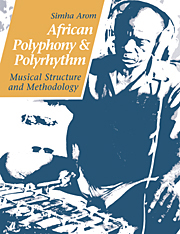Book contents
- Frontmatter
- Contents
- List of illustrations
- Foreword by György Ligeti
- Preface
- Acknowledgements
- BOOK I THE MUSIC OF THE CENTRAL AFRICAN REPUBLIC
- BOOK II AFRICAN POLYPHONIC MUSIC
- BOOK III TECHNICAL TOOLS: METHODS OF RECORDING POLYPHONIC MUSIC FOR TRANSCRIPTION
- BOOK IV THEORETICAL TOOLS
- BOOK V THE ORGANISATION OF TIME IN AFRICAN MUSIC
- BOOK VI STRUCTURAL PRINCIPLES AND THEIR APPLICATION
- 1 Typology
- 2 Analytical notions
- 3 Strict polyrhythmics
- 4 Polyrhythmics as a way to polyphony: Hocket
- 5 Polyphony produced by melodic instruments
- 6 The association of polyphony and polyrhythmics
- Conclusion
- Bibliography
5 - Polyphony produced by melodic instruments
Published online by Cambridge University Press: 27 January 2010
- Frontmatter
- Contents
- List of illustrations
- Foreword by György Ligeti
- Preface
- Acknowledgements
- BOOK I THE MUSIC OF THE CENTRAL AFRICAN REPUBLIC
- BOOK II AFRICAN POLYPHONIC MUSIC
- BOOK III TECHNICAL TOOLS: METHODS OF RECORDING POLYPHONIC MUSIC FOR TRANSCRIPTION
- BOOK IV THEORETICAL TOOLS
- BOOK V THE ORGANISATION OF TIME IN AFRICAN MUSIC
- BOOK VI STRUCTURAL PRINCIPLES AND THEIR APPLICATION
- 1 Typology
- 2 Analytical notions
- 3 Strict polyrhythmics
- 4 Polyrhythmics as a way to polyphony: Hocket
- 5 Polyphony produced by melodic instruments
- 6 The association of polyphony and polyrhythmics
- Conclusion
- Bibliography
Summary
DEFINITION AND GENERAL CHARACTERISTICS
Definition
By polyphonic instruments, we mean instruments designed for melodic music, i.e., provided with pitch levels from a predetermined scale, and played in such a way that the musician's hands simultaneously perform two parts which differ in both melody and rhythm.
General characteristics
The three polyphonic instruments found in the Central African Republic are the xylophone, the sanza, and the harp. They are only rarely used independently, their primary function being to provide support for a song which is invariably sung by the musician himself, but may also involve a response from a choir, or simply from a partner. This instrumental support does several things. It defines the periodic and modal framework for the song, and in so doing, furnishes a set of metric, rhythmic, and melodic reference points. The regularity of the invariant periodicity and the stability of the reference points help the musician to develop a nearly automatic motor behaviour, which frees his mind from attention to manual activity. When he has reached this stage, he can devote his attention entirely to melodic and verbal improvisation in his song. Far from confining itself to an organisational function, the instrumental formula provides a sort of ‘launching pad’ for the musician's inspiration by suggesting melodic associations.
Functionally speaking, the xylophone may be set apart from the harp and the sanza, as it is used primarily to accompany group dances. Accordingly, it is habitually a part of larger ensembles, including percussion instruments (particularly drums). The harp and the sanza, however, are used on more intimate occasions, althouth this is not incompatible with the adjunction of one or more percussion instruments, such as double bells or rhythm sticks.
- Type
- Chapter
- Information
- African Polyphony and PolyrhythmMusical Structure and Methodology, pp. 505 - 619Publisher: Cambridge University PressPrint publication year: 1991



